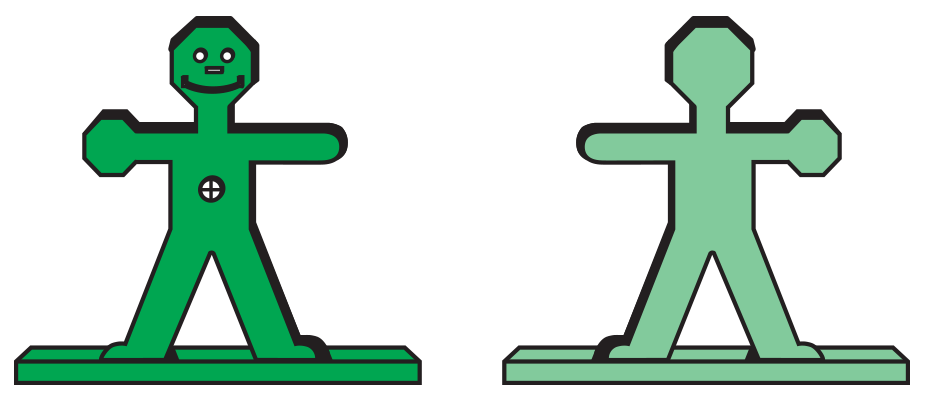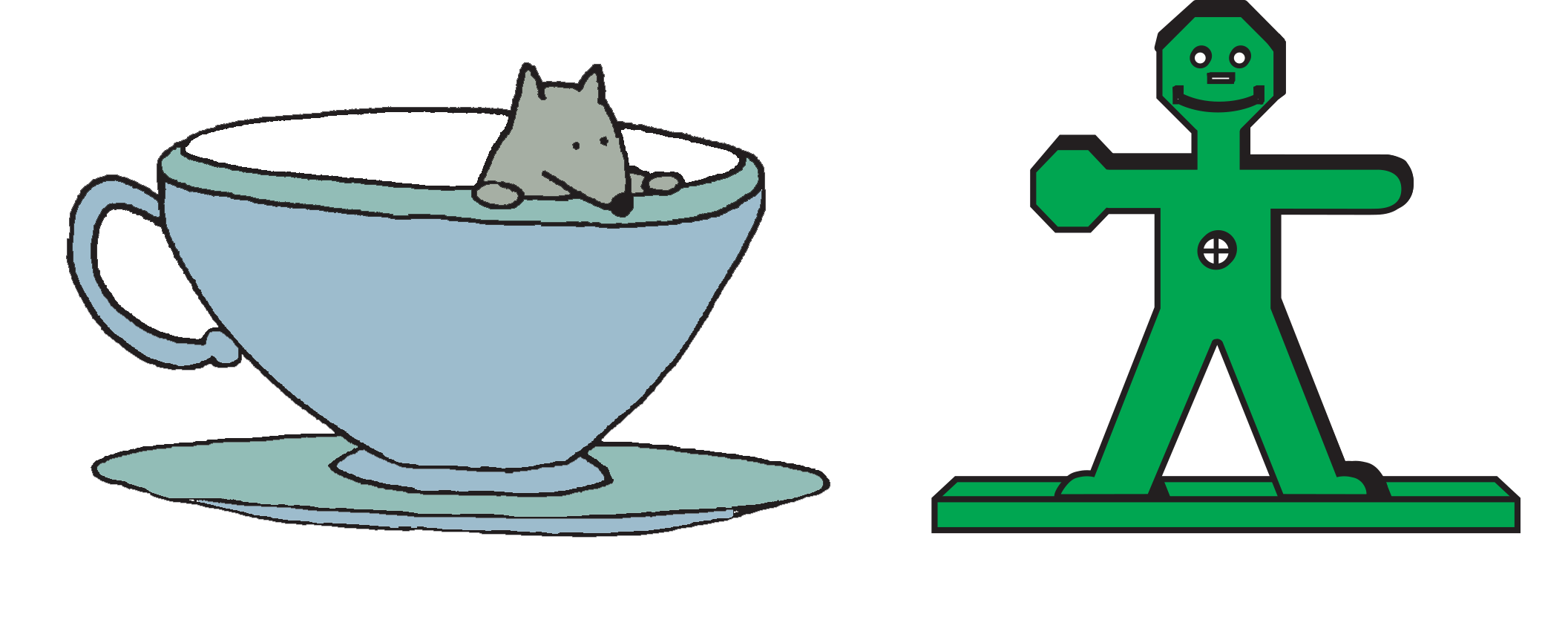Review Right, Left, Front, and Back.
To prepare
students for working with Mr. Origin, check to see
whether they know directions relative to themselves.
Ask all the students to stand facing you.
Ask questions using these or other discussion prompts appropriate to your classroom:
-
Am I in front of you or in back of you?
- Are the [windows] on your right or left?
- What do we mean when we say something is on your right? (Possible responses: The object is
closer to the right hand than the left hand; the object is on the same side that your right hand is on.)
- Is the [clock] in front of you or in back of you?
Students will probably experience little difficulty with the
directions front and back; however, some students will
consistently confuse their right hand with their left. Have
these students place a bracelet or a loose rubber band on
their right wrists to help them identify their right hand.
Ask the students to turn and face the opposite direction.
Use the same discussion prompts as before.
- Did your answers stay the same or change? (They changed.)
- How did the answers to the front/back questions change? (Everything that was in front of me is now in back of me.)
- Why did this happen? (Possible response: I changed the direction I was facing. I am facing the opposite way, but the objects stayed in the
same places.)
- Why did the answers to the left/right questions change? (Possible response: When I turned to face the opposite direction, my right hand also
moved around to the opposite side. Now what was on my right is on my left and what was on my left is on my right.)
- Did everyone have the same answers? Why or why not? (Possible response: We should all have the same answers because we are all facing the same way.)
Move to a position that is in the middle of the students.
Some students should be on your left and
some on your right. Some students should be in front
of you and some in back.
- Am I in front of you or in back of you? (Student
responses will vary depending on where they are
standing in relation to you.)
- Am I on your right or on your left? (Student
responses will vary depending on where they are
standing in relation to you.)
- Do you have different answers from each other
now? Why or why not? (Possible response: Our
answers can’t all be the same because you are in
the middle of us, so you are in front of some of
us and in back of some of us. You are also on the
right of some of us and on the left of some of us.)
Finally, have students turn and face a partner. Ask students to use their right hand to point to the wall to their right.
- Look at your partner. What do you notice? (Possible response: We are each pointing to a different wall.)
- Explain why this is happening. (Possible response: Since we are facing opposite directions our right hands are on opposite sides also.)
Meet Mr. Origin. Introduce Mr. Origin to the class
by showing them your Mr. Origin. See Figure 2.
Have students note Mr. Origin’s distinguishing features
as you give the following explanation:
- This is Mr. Origin. Mr. Origin helps us learn about directions and distances. A mitten is on his right hand. The mitten helps us tell right
from left. The button and face tell us that this is Mr. Origin’s front side.
Let students compare the front and back-sides of Mr. Origin.
- What is different about Mr. Origin’s two hands? (Possible response: One hand is bigger than the other hand. It is shaped like a hexagon.)
- What does the “mitten” on Mr. Origin’s hand tell
you? (Possible response: The mitten is on
Mr. Origin’s right hand so it points to things that
are on Mr. Origin’s right side.)
- What do you see on Mr. Origin’s front side that is
missing from his back side? (Possible response:
Mr. Origin has a button on the front but not on
the back.)
Display the top part only of the Look at Mr. Origin and the Cup Master as shown in Figure 3.
- Is the cup on Mr. Origin’s right or on his left? (right) How do you know?
(Possible response: The cup is on the same side as his right hand.)
Uncover the rest of the display of the
Look at Mr. Origin and the Cup Master. See Figure 4. Point out
that in the bottom picture Mr. Origin has turned around so his back is showing.
Ask students to compare the picture of Mr. Origin at the top of the page to the one of him at the bottom of the page.
- What differences do you notice in these two pictures?
(Possible responses: In the top picture you
can see Mr. Origin’s face and his button but you
can’t see either of these things in the bottom picture
of Mr. Origin. In the top picture his right
hand is on the same side as the cup but in the bottom
picture, his right hand is on the opposite side
of the cup. His left hand is closest to the cup in
the bottom picture.)
Give each student a Mr. Origin you prepared. See
Materials Preparation. Ask students to hold their Mr.
Origins in front of them so that both the student and
Mr. Origin are facing you, the teacher.
- Are you looking at the front of Mr. Origin or the back of Mr. Origin? (back) How do you know?
(I can’t see his button or his face.)
- Is Mr. Origin in front of you or behind you? (He is in front of me.)
- Are you in front of Mr. Origin or behind him? (I am behind him.)
- Use your right hand to point to the wall to your right. Look to see where Mr. Origin’s right hand is
pointing. Are both your right hand and Mr. Origin’s right hand pointing to the same wall? (yes)
Now have the students turn their Mr. Origins around so that the students are looking at Mr. Origin’s face.
- Are you looking at the front of Mr. Origin or the back of Mr. Origin? (front) How do you know? (I can see his button and his face.)
- Is Mr. Origin in front of you or behind you? (He is in front of me.)
- Are you in front of Mr. Origin or behind him? (I am in front of him.)
- How can Mr. Origin be in front of you and you can also be in front of Mr. Origin at the same time?
(Possible response: When we are facing each other we are both in front of each other.)
- Use your right hand to point to the wall to your right. Look to see where Mr. Origin’s right hand is
pointing. Are both your right hand and Mr. Origin’s right hand pointing to the same wall? (no)
- Explain why both of your right hands are pointing to a different wall. (Possible response: Since we
are facing each other our right hands are on opposite sides.)
Play Mr. Origin Says. Students should now be
ready to apply what they learned from your introduction
to Mr. Origin. The class will play “Mr. Origin
Says,” a variation of the game “Simon Says.” Advise
students to hold their Mr. Origin figures upright,
with the heads up. You will give the students instructions
about how to turn their Mr. Origins. Each set of
instructions begins with “Mr. Origin says,” After
each “Mr. Origin says,” have students move their
Mr. Origins to make the statement true. Some model
statements follow but you can create your own.
- Mr. Origin says, “The door is on my right.”
- Mr. Origin says, “The door is on my left.”
- Mr. Origin says, “The teacher’s desk is behind me.“
- Mr. Origin says, “The windows are on my left.”
- Mr. Origin says, “The clock is in front of me.”
Play the game for a few minutes. You may interrupt the game a few times to ask individual students to
explain how their positioning of Mr. Origin fits the prompt that was given.
















